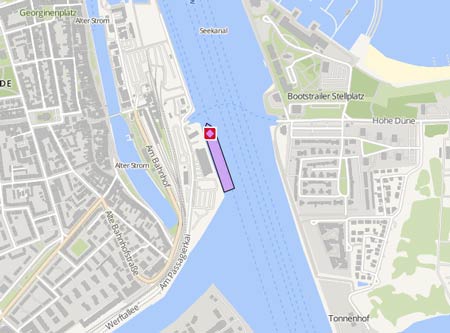CMA CGM SHANGHAI
Course/Position
Latest ports
Latest Waypoints
Latest news
NTSB report: Data entry error led to container loss
The National Transportation Safety Board (NTSB) revealed on Feb 25, 2025, that a data entry error led to the loss of 23 containers and damage to 10 others aboard the 'President Eisenhower', now sailing as 'CMA CGM Shanghai', on Feb 6, 2024, while the vessel was drifting approximately 94 miles south of Oakland, California, awaiting berth assignment. The total value of lost cargo and vessel damage exceeded $735,000. The ship was operating its regular route between Southeast Asia and the U.S. West Coast when the incident occurred. Despite regular inspections showing no apparent issues during the voyage, the situation deteriorated rapidly when the vessel began drifting while awaiting port entry. At approximately 9.35 p.m., crew members noticed what appeared to be smoke on the port side of the vessel. Investigation revealed it was actually powder in the air from collapsed containers, with multiple units missing from bay 42. According to the NTSB investigation, the root cause was traced to incorrect cargo weight data entered during the booking process. A booking agent manually entered erroneous weights of 2,500 kilograms (5,511 pounds) for 39 containers, significantly underreporting their actual weights, which ranged between 24.5 and 28.6 metric tons (54,000-63,000 lbs). The cargo loading plan included inaccurate VGMs [verified gross mass], causing the container stack weights to exceed the maximum weight limit. The error resulted in containers being stacked in a dangerous reverse stratification arrangement, where heavier containers were placed above lighter ones, creating an unstable high center of gravity. This configuration, combined with the vessel’s 18-degree rolling motion in deteriorating weather conditions, ultimately led to the failure of cargo-securing equipment. The vessel would not have sailed with that configuration, had it been known, stated the operating company. In response to the incident, the booking agent has implemented new safety measures, including automatic VGM capture from original bookings when modifications are made and mandatory verification of reported VGMs less than 10 metric tons. Full report: https://www.ntsb.gov/investigations/AccidentReports/Reports/MIR2506.pdf
Report: improperly-installed compression fitting and uninsulated exhaust system insulation caused fire
The National Transport Shipping Board has determined that a loose pipe fitting caused the engine room fire and blackout aboard the 'President Eisenhower' off California on April 27, 2021. The second engineer had installed a new section of steel tubing for the fuel oil return for the main engine, replacing a section that had developed a pinhole leak on April 26. The next day, at 7 p.m. the vessel departed the Port of Los Angeles for Oakland via the Santa Barbara Channel. After ramping up the engine load program for the transit, the first and second engineers completed a walkaround. All looked good, and at 12.53 a.m. they left the engine room for the night. At 01.54 a.m. an AB on the bridge wing noticed smoke coming from an engine room hatch. At about the same time, a fire alarm activated for the engine room. Looking at the CCTV monitor for the space, the captain and third mate confirmed that there was an active engine room fire in progress. The crew followed procedure, shutting down ventilation systems, closing fuel supply valves, switching to the emergency generator, and suiting up firefighting teams. As a first attempt, the crew sent in an attack team with a hose to try and quell the fire, but they quickly determined that it was"too much to fight and retreated. The captain ordered all ventilation hatches to the space closed and the fixed firefighting CO2 system activated. This was completed at about 02.23 a.m. After flooding the space with CO2, they allowed the fire-affected areas to cool throughout the morning to ensure that there would be no reflash. The fire left the vessel without propulsion, and as the day progressed, the 'President Eisenhower' drifted closer to shore. A tug arrived on scene at about 2 p.m. and helped move the stricken ship further out into the channel; at her closest approach to land, she was about 3.5 miles from shore. A marine firefighting team came aboard and helped the crew verify that the blaze was fully extinguished, and the ship was towed back to the Port of Los Angeles for repairs. In a post-casualty examination, investigators found that a compression fitting on the end of the tubing had come fully disconnected, resulting in a spray of diesel fuel. Footage from the vessel's camera system showed that the diesel spray began fully 30 minutes before the fire started. The diesel hit an uninsulated exhaust system component, sparking a blaze. The NTSB concluded that the improperly-installed compression fitting and the uninsulated exhaust system component were the probable causes of the fire. It added that the fitting's failure might not have resulted in a fire if the vessel had had a rapid oil leak detection system, which could have spotted the fuel spray and sounded an alarm before it ignited. Report with photo: https://www.maritime-executive.com/article/improperly-installed-fuel-line-caused-engine-room-fire-on-apl-boxship
Engine fire disabled container ship
On April 28, 2021 at 3 a.m., a fire broke out in the engine room of the 'President Eisenhower' short after leaving the port of Los Angeles enroute to Oakland. The vessel was disabled and went adrift about 24 nautical miles off the Gaviota Coast. The US Coast Guard deployed a helicopter, a small boat and the cutter 'Blacktip' from Ventura to assist the crew in putting out the fire. No one was injured. The ship was drifting in a northerly direction, away from the Channel Islands and their surrounding marine sanctuary. The tug 'Ryan I' (MMSI: 367104050) was called to assist. On April 29 the tugs 'Delta Billie' (IMO: 9562207), 'Elizabeth C' (IMO: 7517478 ), 'Shirley C' (IMO: 7114288) and 'Teresa Brusco' (MMSI: 368019930) were pulling the casualty towards Santa Barbara with a speed of less thant three knots.
Upload News

